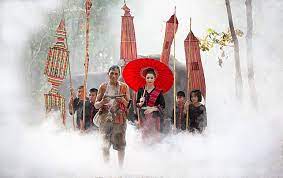Essence of Cultural Living:
Cultural Exploration: Engaging in diverse cultural experiences, whether through cuisine, festivals, music, dance, or art, fosters an appreciation for different ways of life.
Cultural Identity: Embracing one's cultural heritage—language, history, folklore—while respecting and learning from other cultures' identities.
Cross-Cultural Connections: Building bridges between different communities, fostering understanding, empathy, and dialogue across cultural boundaries.

Cultural Expression and Arts:
Artistic Diversity: Exploring various art forms—visual arts, literature, performing arts—reveals the unique expressions and creative narratives inherent in different cultures.
Preservation of Traditions: Valuing and safeguarding cultural traditions, rituals, and craftsmanship passed down through generations to maintain cultural authenticity.
Cultural Institutions: Museums, cultural centers, and heritage sites serve as repositories of history, artifacts, and stories, allowing for a deeper understanding of cultures.
Language and Communication:
Multilingualism: Embracing diverse languages fosters cultural exchange, understanding, and the preservation of linguistic heritage.
Cross-Cultural Communication: Navigating nuances in communication styles and understanding cultural context facilitates meaningful interactions across cultures.
Language Preservation: Efforts to preserve endangered languages, dialects, and linguistic diversity contribute to safeguarding cultural heritage.
Cultural Practices and Rituals:
Festivals and Celebrations: Participating in cultural festivals and celebrations offers insights into unique customs, beliefs, and community spirit.
Ceremonial Traditions: Rituals surrounding life events—birth, coming-of-age, marriage, and death—reflect cultural values and heritage.
Cultural Etiquette: Understanding social norms, etiquette, and customs fosters respect and appreciation when engaging with diverse cultures.
Cultural Awareness and Global Citizenship:
Cultural Sensitivity: Developing empathy and cultural sensitivity toward diverse perspectives, beliefs, and values promotes tolerance and inclusivity.
Global Engagement: Engaging in global issues, advocating for cultural preservation, and supporting marginalized cultures promote global citizenship.
Cultural Diplomacy: Leveraging cultural exchange programs, artistic collaborations, and educational initiatives for cross-cultural understanding and peacebuilding.
Challenges and Adaptation:
Cultural Assimilation: Balancing preservation of cultural identity with the influences of globalization and changing societal norms poses challenges for many communities.
Cultural Conflict: Navigating cultural clashes, stereotypes, and misunderstandings requires open dialogue, empathy, and a willingness to learn.
Cultural Revitalization: Efforts to revitalize fading traditions, languages, and crafts amid modernization and globalization require community support and government initiatives.
Legacy and Cultural Influence:
Cultural Legacy: Passing down cultural knowledge, traditions, and values to future generations ensures the continuity and preservation of heritage.
Cultural Innovation: Embracing innovation while respecting cultural traditions fosters creative adaptations, allowing cultures to evolve while maintaining their essence.
Cultural Exchange and Understanding: Facilitating cultural exchanges, intercultural dialogue, and educational programs promotes mutual respect and understanding among diverse cultures.
Living a cultural lifestyle isn't confined to a specific geography; it's an exploration and appreciation of the myriad human experiences and expressions that shape our world. It's about cherishing diversity, embracing traditions, fostering connections, and celebrating the unique cultural mosaic that unites humanity.
Cultural Exploration and Travel:
Cultural Tourism: Traveling to experience diverse cultures firsthand, immersing in local customs, traditions, and heritage sites to gain a deeper understanding.
Homestays and Cultural Exchanges: Engaging in homestays or cultural exchange programs allows for authentic interactions with local communities, fostering cultural immersion.
Ethnographic Research: Studying cultural practices, rituals, and traditions through anthropological research, shedding light on diverse cultural norms and beliefs.
Diversity in Food and Cuisine:
Culinary Traditions: Exploring diverse cuisines, ingredients, and cooking techniques unique to various cultures offers insights into their history and social customs.
Food as Identity: Understanding the cultural significance of food, its role in rituals, celebrations, and social gatherings reflects cultural identities and traditions.
Food Diplomacy: Culinary exchanges, food festivals, and gastronomic diplomacy foster cultural exchange and appreciation through shared culinary experiences.
Cultural Innovation and Contemporary Expressions:
Contemporary Arts and Fusion: Exploring contemporary art forms, music, literature, and films that blend traditional elements with modern expressions.
Artistic Revival: Initiatives to revive traditional art forms, craftsmanship, and performing arts to ensure their relevance in contemporary society.
Digital Culture and Creativity: Exploring how technology and digital platforms are shaping new cultural expressions, promoting global connectivity and creativity.
Cultural Identity and Belonging:
Diaspora and Identity: Exploring the cultural identity of diasporic communities, their contributions, and how they preserve and evolve their heritage.
Intercultural Families: Navigating the fusion of multiple cultures within families, fostering cross-cultural understanding, and transmitting diverse values.
Cultural Symbols and Meaning: Understanding the significance of symbols, attire, rituals, and gestures in different cultures, reflecting deeper cultural meanings.
Gender and Cultural Roles:
Gender in Cultural Practices: Exploring how different cultures define gender roles, norms, and the evolution of these roles within societies.
Feminism and Cultural Empowerment: Understanding cultural contexts in advocating for gender equality and empowerment within diverse cultural frameworks.
LGBTQ+ Identities and Culture: Recognizing the intersectionality of cultural identity and LGBTQ+ experiences, understanding diverse cultural perspectives on gender and sexual orientation.
Cultural Preservation and Endangered Traditions:
Endangered Languages: Efforts to preserve and revitalize endangered languages, acknowledging their importance in preserving cultural heritage.
Threats to Cultural Heritage: Addressing challenges such as cultural appropriation, globalization, and modernization impacting traditional practices.
Cultural Heritage Protection: Supporting initiatives to safeguard cultural heritage sites, artifacts, and intangible cultural heritage recognized by UNESCO and other organizations.
Cultural Healing and Well-being:
Cultural Therapy and Healing Practices: Exploring traditional healing methods, rituals, and spiritual practices that promote mental and physical well-being.
Community Healing Practices: Understanding communal healing practices, ceremonies, and rituals that facilitate healing after social or natural disasters.
Art Therapy and Cultural Expression: Using artistic expression and cultural activities for therapeutic purposes, promoting mental health and emotional well-being.
The cultural lifestyle encompasses an ever-evolving tapestry of traditions, expressions, and human experiences that shape societies globally. It's a continuous journey of exploration, appreciation, and respect for the diverse cultural narratives that weave the fabric of our shared humanity.



You must be logged in to post a comment.